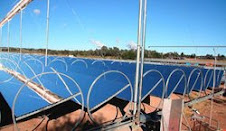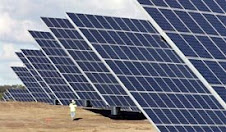Mokai, New Zealand [RenewableEnergyAccess.com] With the recent opening of the Tuaropaki Power Company (TPC) for the Mokai Geothermal Power Station extension, accompanied by congratulations from the New Zealand Geothermal Association, TPC's Mokai becomes the sixth largest electricity generator in New Zealand, with the ability to generate almost 2% of New Zealand's total electricity requirements. The 39 MW extension brings the total Mokai output up to 94 MW, placing it among New Zealand's top 15 stations in terms of annual output.
10 year target to be as high as 400 MW of geothermal power
The station is based around what is known as binary cycle technology. While geothermal steam does pass directly through a steam turbine, geothermal heat from steam and water is passed to a second "organic" working fluid that drives other turbines. Large banks of air-cooled heat exchangers are another feature of the station. The station was designed and built by Ormat of Israel and is similar to the Rotokawa station near Taupo, or to other designs internationally. The overall result is an efficient geothermal power station, providing a reliable base load of generation that is independent of rainfall or wind.
The heat exchanger arrangements around the station mean that there is normally no direct release of geothermal steam at the surface. A small amount of carbon dioxide comes with the geothermal fluid and is vented above the cooling towers. The carbon dioxide emissions are about one sixth of that of a gas-fired combined cycle power station of the same MW output. Geothermal water and condensate are reinjected into the Mokai reservoir.
The station is normally quiet and is not expected to disturb either the local farm workers or farming operations. It has a low profile, sitting on farmland surrounded by low-lying hills and is not directly visible from main roads out of Taupo.
The Tuaropaki Power Company (TPC) was wholly owned by the Tuaropaki Trust, which administers 2,700 hectares (ha) of Maori lands that overlie most of the Mokai geothermal field. The Trust runs a successful pastoral farming operation and has an interest in a large geothermally heated glass house on its land.
Due to the long-term relationship between TPC and state-owned generator Mighty River Power, Mighty River Power has an agreement to operate and manage the Mokai power station, having bought a 25% equity holding in TPC in 2003.
Many other geothermal fields in New Zealand are currently untapped or underdeveloped, and could potentially be developed assuming access and consent is achieved. Today 450 MW of installed geothermal capacity is in New Zealand, and geothermal stations supply 6-7% of the nation's electricity demand.
Geothermal energy is expected to make an even greater contribution to supplying New Zealand's increasing demand for electricity. Some developers have spoken of 400 MW of geothermal power stations over the next 10 years.
Best Green Stocks Investing Blog
Subscribe to:
Post Comments (Atom)
Yuya Joe Blog
Lake Ontario Waterkeeper
The Daily Beast -Politics Blog
21stArch.com - 21st Century Architecture
Original Joe College Blog
WikiLeaks Foreign Policy Analysis
AGreenRealtor.com Real Estate Blog - Ecology Energy Efficiency
Best Green Stocks Investing Blog
PV Intell Photovoltaic Solar Stocks Investing
SEARCH Leading Alternative Energy and Ethical Investing websites

Custom Search
Daily Kos
Rare Earth Stocks Research
Patrick MacManus's Blog Peace and Collaborative Development
BeesTreesFrogsElephants.com - Nature and Ecology Blog
Research Green Energy stocks, Clean Energy investing information
Find wind power investing info online, clean energy mutual funds, geothermal stocks, solar energy investments.

Green Energy Investing Network:
Green Stocks Investing Clean Power Blog
SolarIntell.com Renewable Power Investing Website
Wind Intell.com Wind Energy Stocks Company Links
Geothermal Power Investing Public Companies
PV Intell.com Leading Photovoltaic Solar Energy Stocks

Custom Search
Green Energy Investing Network:
Green Stocks Investing Clean Power Blog
SolarIntell.com Renewable Power Investing Website
Wind Intell.com Wind Energy Stocks Company Links
Geothermal Power Investing Public Companies
PV Intell.com Leading Photovoltaic Solar Energy Stocks







No comments:
Post a Comment